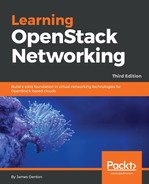Neutron enables users to build routers that provide connectivity between networks created by users and external networks. In a reference implementation, the Neutron L3 agent provides IP routing and network address translation for virtual machine instances within the cloud by utilizing network namespaces to provide isolated routing instances. By creating networks and attaching them to routers, users can expose connected virtual machine instances and their applications to the internet.
Prior to the Juno release of OpenStack, users were limited to building standalone routers that acted as single points of failure in the network stack. Since the advent of distributed virtual routers in Juno and beyond, standalone routers are now referred to as legacy routers. While the preference may be to provide resiliency in the form of highly-available or distributed virtual routers, standalone routers provide the simplest implementation of the three options.
In previous chapters, we discovered the difference between provider and self-service project networks and demonstrated the process of booting an instance and connecting it to the network. In this chapter, we will work through the following:
- Installing and configuring the L3 agent
- Creating an external provider network
- Creating a standalone router in the CLI and Horizon dashboard
- Attaching a router to both external and tenant networks
- Booting instances
- Demonstrating instance and namespace connectivity using Linux bridges
- Demonstrating SNAT and DNAT functionality provided by floating IPs
